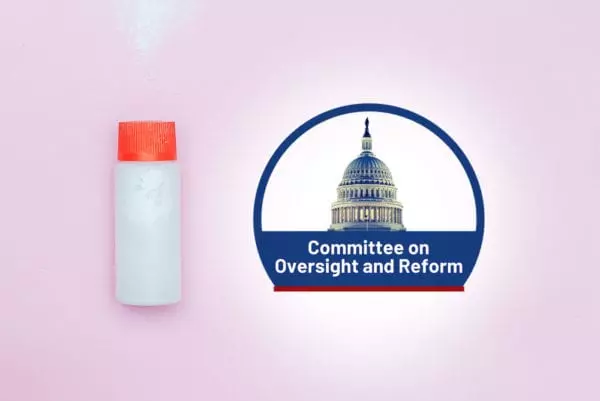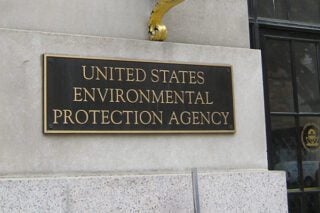
On December 5, the House Committee on Oversight and Reform held a hearing to examine the cancer-causing properties of asbestos-contaminated talc products and methods for asbestos detection. The hearing came after Johnson & Johnson’s talcum powder products were again under fire for asbestos contamination.
In October 2019, 33,000 bottles of Johnson & Johnson baby powder were recalled due to trace levels of chrysotile asbestos contamination. Despite the U.S. Food and Drug Administration’s (FDA’s) findings of contamination, Johnson & Johnson was unable to detect asbestos in its products and disputed the claims. The committee called for better, more sensitive testing methods to detect asbestos, in order to protect public health and keep dangerous products off store shelves.
Subcommittee Questions Johnson & Johnson’s Talc Use
The hearing, titled “Examining Carcinogens in Talc and the Best Methods for Asbestos Detection,” aimed to identify methods for better asbestos testing in products and hold Johnson & Johnson accountable for its distribution of asbestos-contaminated talcum powder. Johnson & Johnson CEO Alex Gorsky was set to attend the hearing, but declined an invitation to voluntarily testify under oath.
According to Congressman Raja Krishnamoorthi, Chairman of the Oversight Subcommittee on Economic and Consumer Policy, laboratory tests have shown Johnson & Johnson talc-based products have been contaminated with asbestos for decades. The subcommittee discussed evidence Johnson & Johnson employees knew about the asbestos contamination during this time. Evidence alleged company employees even discussed suppressing the use of more sensitive asbestos-detection methods.
In the hearing, Krishnamoorthi also stated the company has been repeatedly asked to label its powder with a cancer warning due to these findings. Instead, the subcommittee alleged, Johnson & Johnson increased a marketing plan to people of color.
The company also commissioned a market survey consultant to understand the public perception of the powder’s name. Because the consultant found women preferred cornstarch-based products and had an aversion to talc, the company prominently featured a cornstarch label on those products. However, the company didn’t label talc clearly on its talc-based baby powder.
During the hearing, Dr. William Longo, a scientist for Materials Analytical Services, LLC, testified as a witness. He delivered the findings of his laboratory, Materials Analytical Services, which served as an independent laboratory to conduct asbestos testing of Johnson & Johnson products.
He analyzed samples of Johnson & Johnson’s baby powder from the 1940s to the 2000s, along with the company’s current products. He tested the products for asbestos using the Heavy Liquid Separation (HLS) technique, which is more sensitive than the testing methods used by Johnson & Johnson. Overall, Dr. Longo discovered 65% of all samples tested positive for asbestos.
Dr. Longo explained in his testimony, “The cosmetic talc industry has, in that time, accumulated hundreds, if not thousands of testing results that report ‘no detectable or quantifiable asbestos.’ These reports, regarded by the manufacturers as ‘negative,’ are very misleading as they result from analytical and methodological techniques with poor detection limits.”
Despite these findings, Johnson & Johnson continues to argue its products are asbestos-free. The company further claimed the tests conducted by Dr. Longo’s lab did not actually test for asbestos, but rather found another substance.
In the FDA’s laboratory testing of the products, they utilized a standard method of testing rather than HLS techniques. The tests still indicated the presence of chrysotile asbestos fibers, but Dr. Longo indicated amphibole asbestos fibers could have also been found if the FDA used a more advanced testing method.
Talc Linked to Asbestos-Related Disease
Dr. Jacqueline Moline, a physician at Feinstein Institutes for Medical Research at Northwell Health, offered insights from 33 mesothelioma patients who were exposed to asbestos from talcum powder.
Dr. Moline noted talcum powder was the only instance of asbestos exposure among all 33 patients in the study. She further stated mesothelioma is deemed a signature disease, as it almost always is the result of exposure to asbestos.
“To this day, they’re finding asbestos in talcum powder on the shelves, and it’s putting thousands, if not millions, of people at risk,” said Dr. Moline in her testimony.
Dr. Moline affirmed there is no safe level of asbestos in talc products or any products, as the mineral is a proven carcinogen.
In more recent years, the FDA has increased efforts in testing for asbestos in talc and cosmetic products. In 2008 and 2010, records showed the FDA selected AMA Laboratories Inc. to conduct asbestos testing of cosmetic products. AMA detected asbestos in Johnson & Johnson baby powder, stating that detecting asbestos in cosmetics requires the most sensitive laboratory tests available.
Despite this, Dr. Longo doesn’t believe AMA used the most sensitive tests during this time. He argued asbestos fibers would have been detected sooner if the most advanced technology was used in testing procedures.
In the future, Dr. Longo believes HLS should be used as the standard for asbestos testing in the United States. Dr. Longo explained HLS has already been adopted as the international standard for its sensitivity.
Due to the microscopic nature of asbestos fibers, hundreds of millions of fibers may be present in a given sample, so it is essential for the most advanced technology to be used to identify its presence. Even when using the most advanced technology, it can be difficult to confirm asbestos is present in a given product, as the threshold is 4,500 fibers per gram.
“At this very moment, I am sending a document request to Johnson & Johnson seeking answers,” said Krishnamoorthi in his closing remarks of the panel.
In response to this hearing, the FDA also continues to call for better test methods in order to protect public health.




